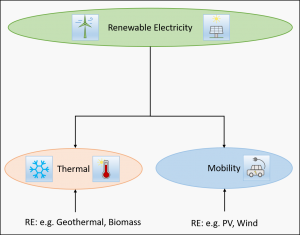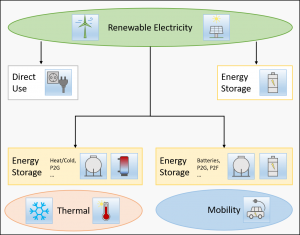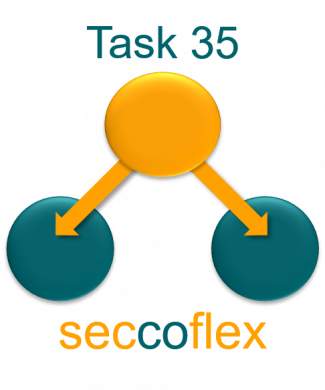Read the Final Report and Executive Summary of Task 35 here: https://iea-es.org/publications/type/final-reports
The main input of renewable energy to the future power grid will be renewable electricity by wind and photovoltaics. Reaching higher shares of fluctuating renewables in the power grid may cause a variety of problems. One option to tackle these challenges, by simultaneously further increasing the share of renewable electricity in the overall energy system, is to distribute renewable electricity to other sectors, mainly the heating/cooling and the mobility sector.

The figure above shows the interaction of three sectors, namely electricity, thermal (heating/cooling) and mobility without any storage technologies. Each sector can have its own direct input from a renewable energy source. However, most of the expected input will come from the electricity sector.
The following figure shows a qualitative approach of how an integration of flexible sector coupling with different storage technologies could look like. A perfect use case for energy storages is at the connection between different sectors. This way the energy is either stored in its input form or transformed to another energy form (e.g. electricity to heat/cooled, electricity to synthetic fuel, Power-to-Gas or Power-to-Heat). By doing so, the different demand patterns of the “consuming” sectors thermal and mobility can help to match the volatile energy supply to a specific demand. It is also worth mentioning that thermal storages are in most cases less expensive then electricity storages and that synthetic fuels allow for a mostly loss free storage of exceed wind and photovoltaic energy to couple the electricity and mobility sector. An application-specific ecological and economic evaluation, in order to quantify the advantages over an uncoupled system, should accompany all mentioned scenarios.

By leveraging the potential of different energy storage technologies, it is possible to supply a sector with previously stored renewable electricity on demand. This approach can help to reduce the stress on the power grid at different levels (high, medium and low voltage). Possible energy storage technologies include thermal, chemical and electrical storages.
Some advantages of “Flexible Sector Coupling by Energy Storage Implementation” are:
- Energy storages are able to increase the share of renewable electricity in other sectors like heating/cooling and mobility sector.
- Energy storage can provide flexibility to all sectors (‘renewables on demand’).
The main goal of this task is to clarify the possibilities and the impact of energy storage implementation in the context of flexible sector coupling.
For more information, please contact: Mr. Andreas Hauer or Mr. Christoph Rathgeber.
The final Task 35 meeting will be held on 29-30 March 2023 in Stuttgart, Germany. It will be part of the Volta-X Energy Systems Expo: https://www.messe-stuttgart.de/volta-x/en
Download the detaillied Draft work plan Flexible Sector Coupling here.
